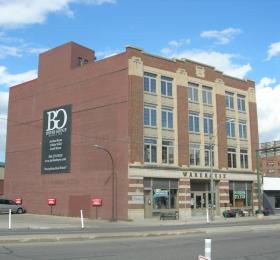Fairbanks Morse Warehouse
- Designated
Description of the Historic Place
The Fairbanks Morse Warehouse is a four-storey brick and concrete building constructed in 1911 in the City’s downtown.
This historic place, located at 14 23rd Street East, was designated as a Municipal Heritage Property in 1985. Designation is limited to the exterior of the building.
Heritage Value
The heritage value of the Fairbanks Morse Warehouse lies in its Chicago style influenced architecture. Built of reinforced concrete in an era dominated by wood-frame warehouses, the building exudes the optimism of Saskatoon’s pre-World War I commercial growth. Designed by the Montreal architectural firm of Brown and Vallance, the building's façade features brick piers at the storefront level, pilasters crowned with modern capitals, geometric spandrels and a stepped pediment. Its storefront, complete with leaded transom lighting, is accented by a belt course. Indiana limestone and Stanstead granite, employed in other Saskatoon buildings designed by these architects, are used in the warehouse’s embellishment.
The heritage value of the Fairbanks-Morse Warehouse also lies in its strong role in Saskatoon’s commercial history, as a product of railway expansion into Saskatoon in the early 20th century. In 1911, the Fairbanks-Morse Company Ltd, Canada’s largest machinery and mill supply house, constructed the building to warehouse its distribution centre for central Saskatchewan which contributed to Saskatoon’s rapid growth. A spur line connecting the warehouse to the nearby rail yard facilitated the delivery of heavy equipment. Like other large commercial buildings in Saskatoon’s warehouse district, the warehouse was subdivided and occupied by various smaller businesses during the 1930s and 1940s. In 1948, the Fairbanks-Morse Warehouse became home to the local Co-operative Commonwealth Federation (C.C.F.) headquarters and also housed a Union hall.
Source: City of Saskatoon Bylaw No.6672 / City of Saskatoon Built Heritage Database / Canadian Register of Historic Places
Character Defining Elements
Key elements which contribute to the heritage value of this historic resource include:
- Its Chicago architectural style, evident in: its piers, pilasters, stepped pediment and the metal spandrels incorporating decorative motifs; and,
- Those elements that reflect its commercial history, such as the building’s location near the rail yards, the storefront windows at ground level, the Warehouse lettering above its storefront, and the building's form, scale and massing.

